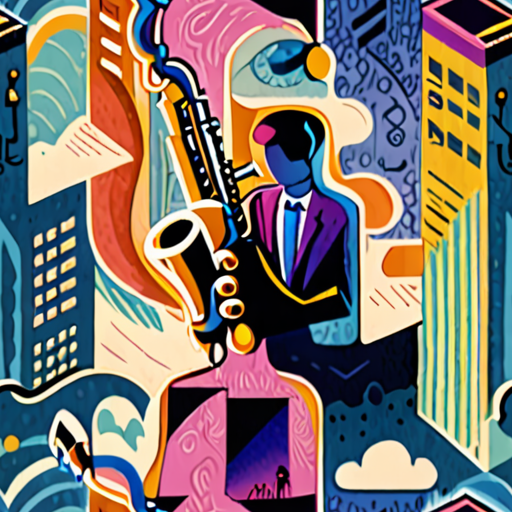“`html
From the vibrant syncopations of bebop to the epic instrumental blends of fusion genres, jazz has continually evolved, traversing an astonishing spectrum of styles and sounds. As it bridges gaps across musical boundaries, jazz fusion emerges as a standout genre, seamlessly intertwining elements of jazz, rock, and beyond. This article takes you through a captivating exploration of jazz fusion, beginning from its roots and pivotal figures right through to its influence on modern-day music. Diving into the key characteristics that define this revolutionary genre, uncovering iconic jazz fusion albums, and highlighting the innovative artists who helped shape it, you’ll discover how jazz fusion has played a pivotal role in expanding musical horizons. Moreover, we’ll delve into its enduring impact on related genres such as jazz rock and rock jazz, providing intriguing examples and tracing its distinct journey from inception to contemporary relevance. Join us as we chart the dynamic evolution of jazz fusion and its enduring legacy within the pantheon of music history.
“`
Fusion Music Genre
Fusion music is a genre that combines elements of different styles, often blending rock, pop, jazz, and classical music to create a unique sound. As a fan of funk, soul, and jazz fusion music, I’m excited to dive into the world of fusion and explore its various sub-genres and characteristics.
Sub-Genres of Fusion Music
Some popular sub-genres of fusion music include:
- Jazz-Rock Fusion: A blend of jazz and rock music, characterized by complex rhythms and improvisational solos.
- Electronic Fusion: A fusion of electronic music with traditional instruments, often featuring synthesizers and drum machines.
- Ambient Fusion: A calming and atmospheric style of fusion music, often incorporating ambient textures and soundscapes.
- World Fusion: A genre that combines elements of traditional music from around the world with modern fusion techniques.
Characteristics of Fusion Music
Fusion music is known for its eclecticism and experimentation, often pushing the boundaries of traditional music genres. Some common characteristics of fusion music include:
- Complex Rhythms: Fusion music often features intricate rhythms and time signatures, drawing inspiration from jazz and classical music.
- Improvisation: Many fusion musicians are skilled improvisers, creating spontaneous melodies and solos during live performances.
- Experimentation: Fusion music often incorporates unconventional sounds and instruments, such as synthesizers, theremins, and electric guitars.
- Cultural Exchange: World fusion music celebrates the diversity of global cultures, combining traditional instruments and musical styles from around the world.
Influential Fusion Musicians
Some notable fusion musicians who have helped shape the genre include:
- Miles Davis: A legendary trumpeter and bandleader who experimented with fusion music in the 1960s and 1970s.
- Herbie Hancock: A pianist and composer who has been a major force in fusion music since the 1960s.
- Weather Report: A jazz-fusion band formed in the 1970s, known for their complex arrangements and virtuosic musicianship.
- Talking Heads: An art-rock band that incorporated elements of fusion music into their eclectic sound.
Conclusion
Fusion music is a vibrant and dynamic genre that continues to evolve and inspire new generations of musicians and listeners alike. By exploring the various sub-genres and characteristics of fusion music, we can gain a deeper appreciation for the creativity and innovation that defines this exciting genre.
Difference Between Fusion and Jazz Fusion
Fusion refers to the blending of two or more distinct musical styles to create something unique, whereas jazz fusion specifically combines elements of jazz with those of other genres, often resulting in a more energetic and experimental sound.
To understand the difference, let’s consider the definition of jazz, which is a genre characterized by improvisation, syncopated rhythms, and a blend of African-American and European musical traditions.
Jazz Fusion Subgenres
Some notable subgenres of jazz fusion include:
- Afrobeat fusion, which incorporates elements of Afrobeat music into jazz fusion
- Funk fusion, which blends jazz fusion with funk music
- Rock fusion, which combines jazz fusion with elements of rock music
- Soul jazz, which emphasizes soulful melodies and harmonies within the context of jazz fusion
Characteristics of Jazz Fusion
Jazz fusion often features complex time signatures, extended instrumental solos, and a strong emphasis on rhythm and groove. Musicians who specialize in jazz fusion may draw upon a wide range of influences, including classical music, world music, and avant-garde experimentation.
As a result, jazz fusion can take many forms, from the more traditional and accessible sounds of artists like Miles Davis and Herbie Hancock to the more experimental and avant-garde approaches of musicians like John McLaughlin and Weather Report.
Tiger Funk’s Perspective
At Tiger Funk, we celebrate the diversity and creativity of jazz fusion, recognizing its importance as a bridge between different musical traditions and its ongoing influence on contemporary music. By exploring the various subgenres and characteristics of jazz fusion, we hope to inspire a deeper appreciation for this dynamic and innovative genre.
Examples of Jazz Fusion
Jazz fusion is a genre that combines elements of jazz, rock, funk, and electronic music.
- The Mahavishnu Orchestra: Known for their complex and intricate compositions, the Mahavishnu Orchestra was a pioneering force in the development of jazz fusion.
- Miles Davis: Miles Davis was a legendary trumpeter who experimented with various styles, including jazz fusion, in his later work.
- Return to Forever: This band, led by Chick Corea, was known for their energetic live performances and innovative blend of jazz, rock, and classical music.
- Weather Report: Formed by Joe Zawinul and Wayne Shorter, Weather Report was a highly influential jazz fusion group that explored a wide range of musical styles.
- Herbie Hancock: Herbie Hancock has been a major figure in jazz fusion, incorporating elements of funk, rock, and electronic music into his work.
- Tony Williams Lifetime: This band, led by drummer Tony Williams, was a key part of the early days of jazz fusion, blending elements of free jazz and rock music.
- Pat Metheny Group: The Pat Metheny Group has been a leading exponent of jazz fusion, combining elements of jazz, rock, and world music in their work.
- John McLaughlin: John McLaughlin has been a key figure in jazz fusion, exploring a wide range of musical styles and collaborating with artists from around the world.
- George Duke: George Duke was a keyboardist and composer who played a significant role in the development of jazz fusion, incorporating elements of funk and rock music into his work.
- Al Di Meola: Al Di Meola has been a leading guitarist in jazz fusion, known for his technical virtuosity and eclectic approach to music.
Jazz fusion has had a profound influence on popular music, inspiring countless musicians and bands across a wide range of genres.

Jazz Fusion Music Genre
Jazz fusion is a genre of music that combines elements of jazz with other styles, such as rock, funk, and world music.
- Characterized by its use of improvisation, complex time signatures, and extended musical forms.
- Often features a blend of electronic and acoustic instruments, creating a unique sound.
- Has been influenced by various cultures and traditions, resulting in a diverse range of sub-genres.
Sub-Genres of Jazz Fusion
- Fusion jazz: A style that emerged in the 1960s, characterized by its experimental approach to jazz.
- Smooth jazz: A sub-genre that emphasizes smooth, melodic sounds and often incorporates elements of R&B and pop music.
- Acid jazz: A style that originated in the UK in the 1980s, characterized by its use of samples and electronic beats.
Influential Artists and Bands
- Miles Davis: A legendary jazz trumpeter who was instrumental in shaping the sound of jazz fusion.
- Herbie Hancock: A pianist and composer who has been a major force in the development of jazz fusion.
- The Mahavishnu Orchestra: An influential band known for their complex and technically demanding music.
Impact on Modern Music
Jazz fusion has had a significant influence on the development of various genres, including rock, pop, and hip-hop.
- Many contemporary musicians have cited jazz fusion as an inspiration for their work.
- The genre’s emphasis on experimentation and innovation has led to the creation of new sounds and styles.
- Jazz fusion continues to evolve, incorporating elements from other genres and pushing the boundaries of what is possible in music.
Jazz Fusion Genres
Jazz fusion, also known as jazz-rock or fusion, is a popular music genre that emerged in the late 1960s.
- Rock Music: Jazz fusion incorporated elements of rock music, including its energetic rhythms and guitar-driven soundscapes.
- Funk: The genre drew inspiration from funk music, characterized by its strong emphasis on rhythm, groove, and percussive beats.
- Rhythm and Blues: Jazz fusion also borrowed from rhythm and blues, incorporating its soulful melodies and harmonies into the genre.
The fusion of these styles resulted in a unique sound that blended the complexity of jazz with the energy and accessibility of rock, funk, and R&B.
This blend of styles allowed jazz fusion artists to push the boundaries of traditional jazz and create something entirely new and innovative.
As a result, jazz fusion became a staple of 1970s music, influencing a wide range of artists and genres, from progressive rock to hip-hop.
Tiger Funk celebrates the rich history and cultural significance of jazz fusion, offering in-depth articles, artist profiles, and album reviews that highlight the evolution of this influential genre.
By exploring the intersection of jazz, rock, funk, and R&B, we can gain a deeper understanding of the creative forces that shaped the music of the 20th century.
From the iconic sounds of Miles Davis and Herbie Hancock to the experimental works of Frank Zappa and Weather Report, jazz fusion continues to inspire new generations of musicians and fans alike.
At Tiger Funk, we’re committed to preserving the legacy of jazz fusion and showcasing its enduring influence on contemporary music.

The Father of Fusion Music
Larry Coryell is often referred to as the Godfather of Fusion, but his influence on the genre is just one aspect of its rich history.
- Tiger Funk celebrates the evolution of funk, soul, and jazz fusion through in-depth articles, artist profiles, and album reviews.
- Fusion music emerged in the late 1960s and early 1970s, blending elements of rock, jazz, and classical music.
- Pioneers like Miles Davis, Herbie Hancock, and Weather Report pushed the boundaries of traditional jazz and created a new sound.
- Coryell’s work with Miles Davis and other jazz legends helped shape the fusion movement, but he is not the sole originator of the genre.
- Other notable figures, such as John McLaughlin and Chick Corea, made significant contributions to the development of fusion music.
Fusion music has had a lasting impact on modern music, influencing artists across various genres.
- Many contemporary musicians have cited fusion as an inspiration, incorporating elements into their own work.
- The genre’s experimental nature and emphasis on improvisation continue to attract new audiences.
- Tiger Funk provides a comprehensive resource for fans and enthusiasts, exploring the history and cultural significance of funk, soul, and jazz fusion.
In conclusion, while Larry Coryell is an important figure in the history of fusion music, he is not the sole “father” of the genre.
The evolution of fusion involved numerous innovators and pioneers who contributed to its unique sound and enduring legacy.
Tiger Funk honors this rich heritage, offering a wealth of knowledge and insight into the world of funk, soul, and jazz fusion.

0 Comments